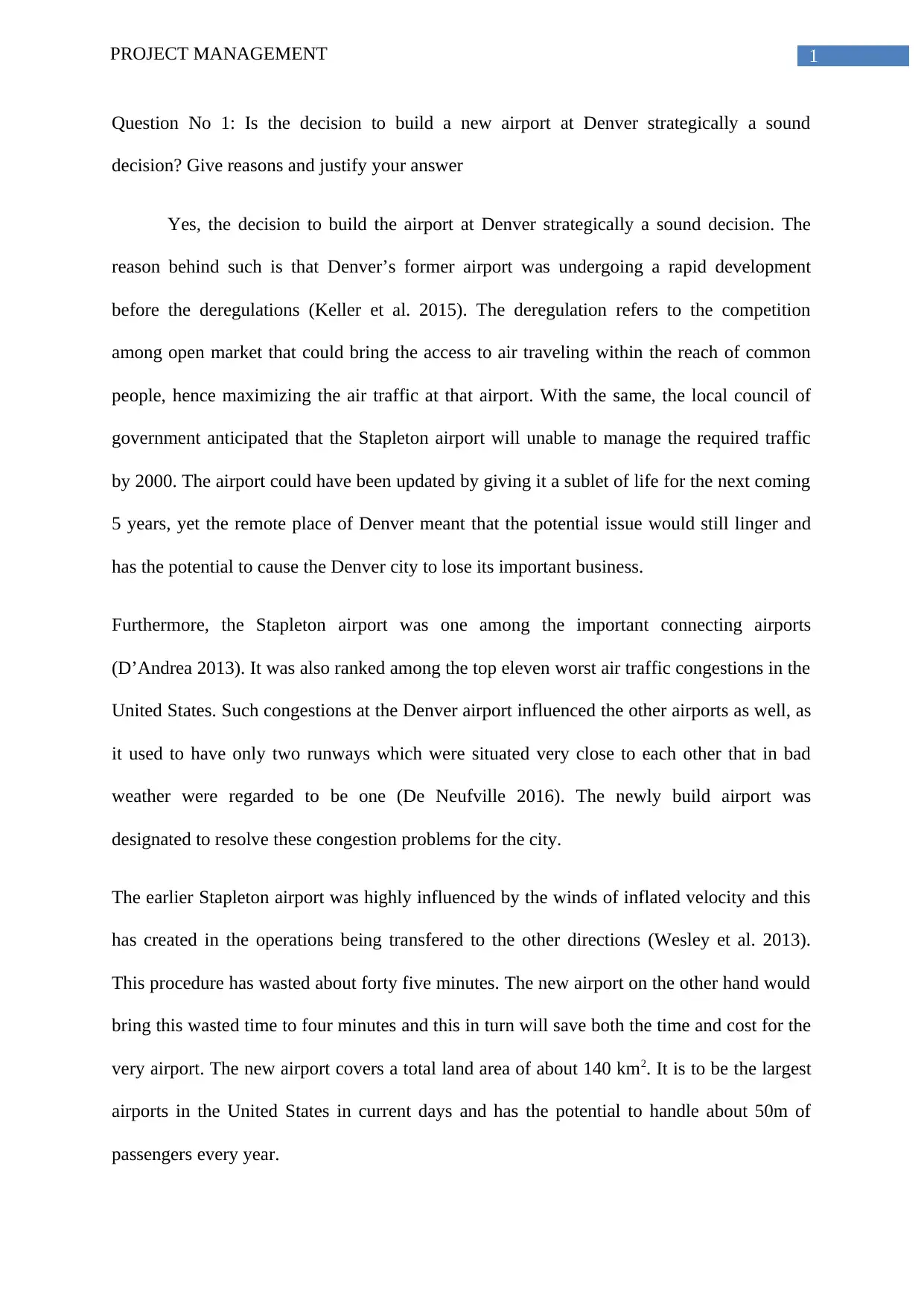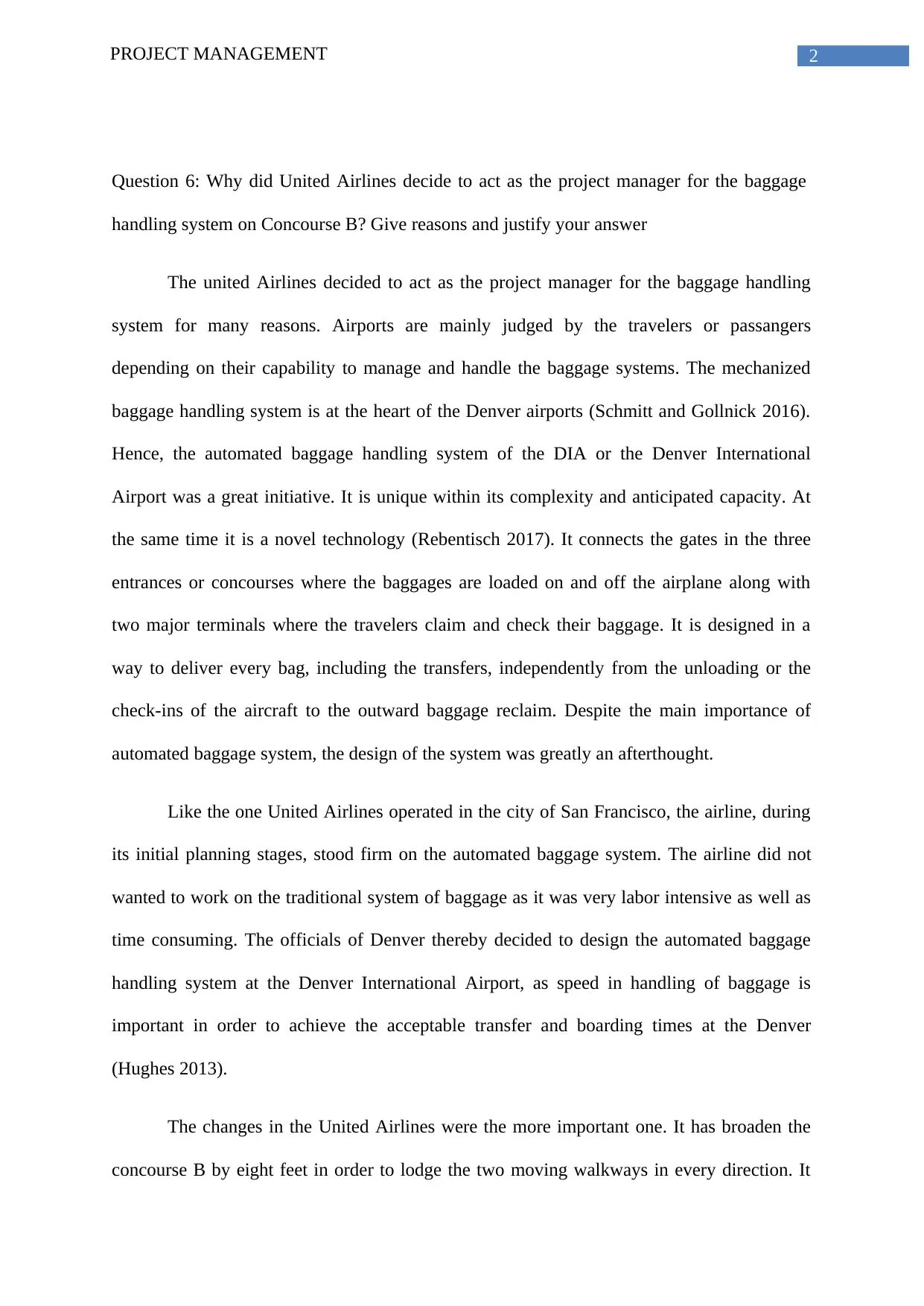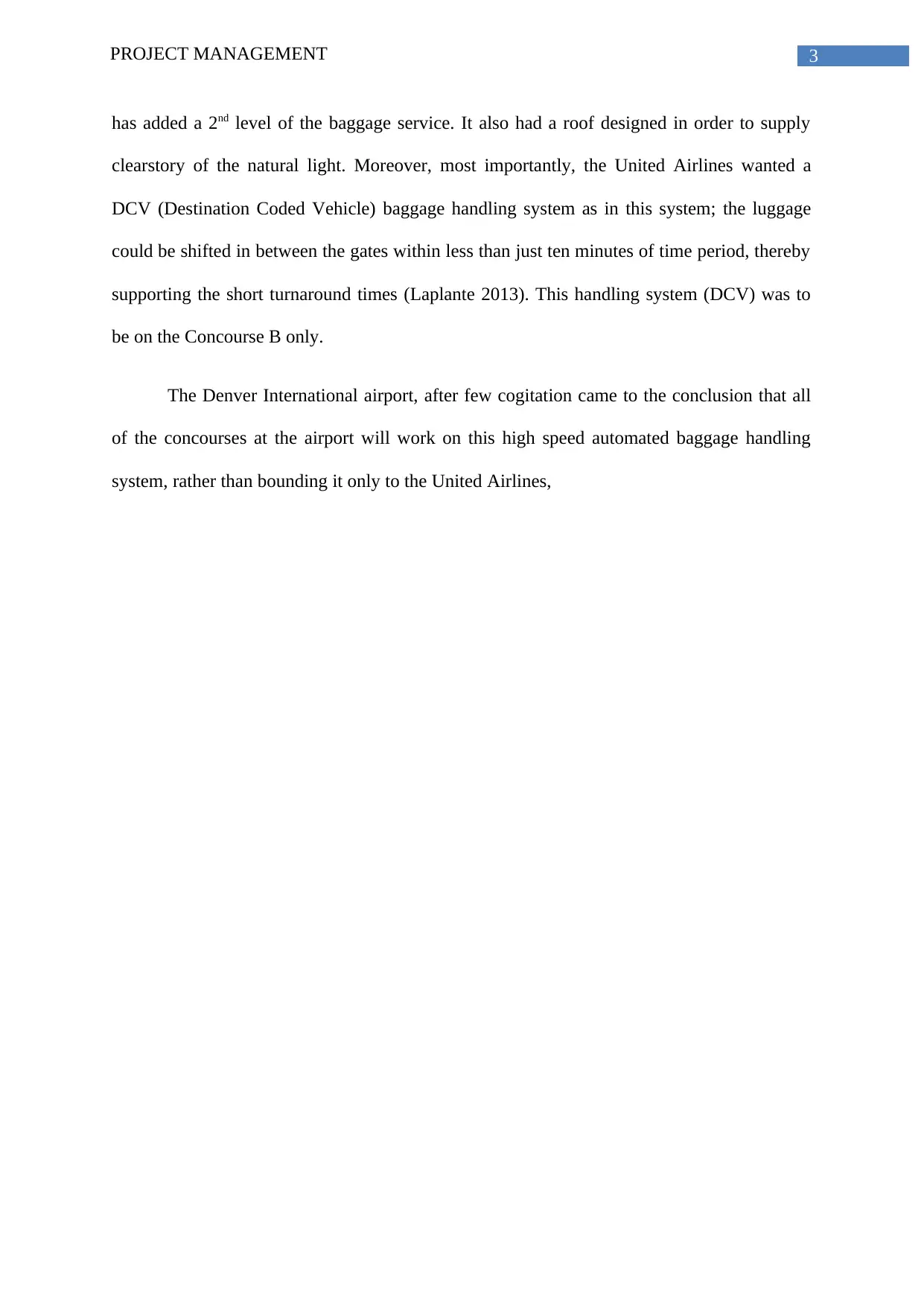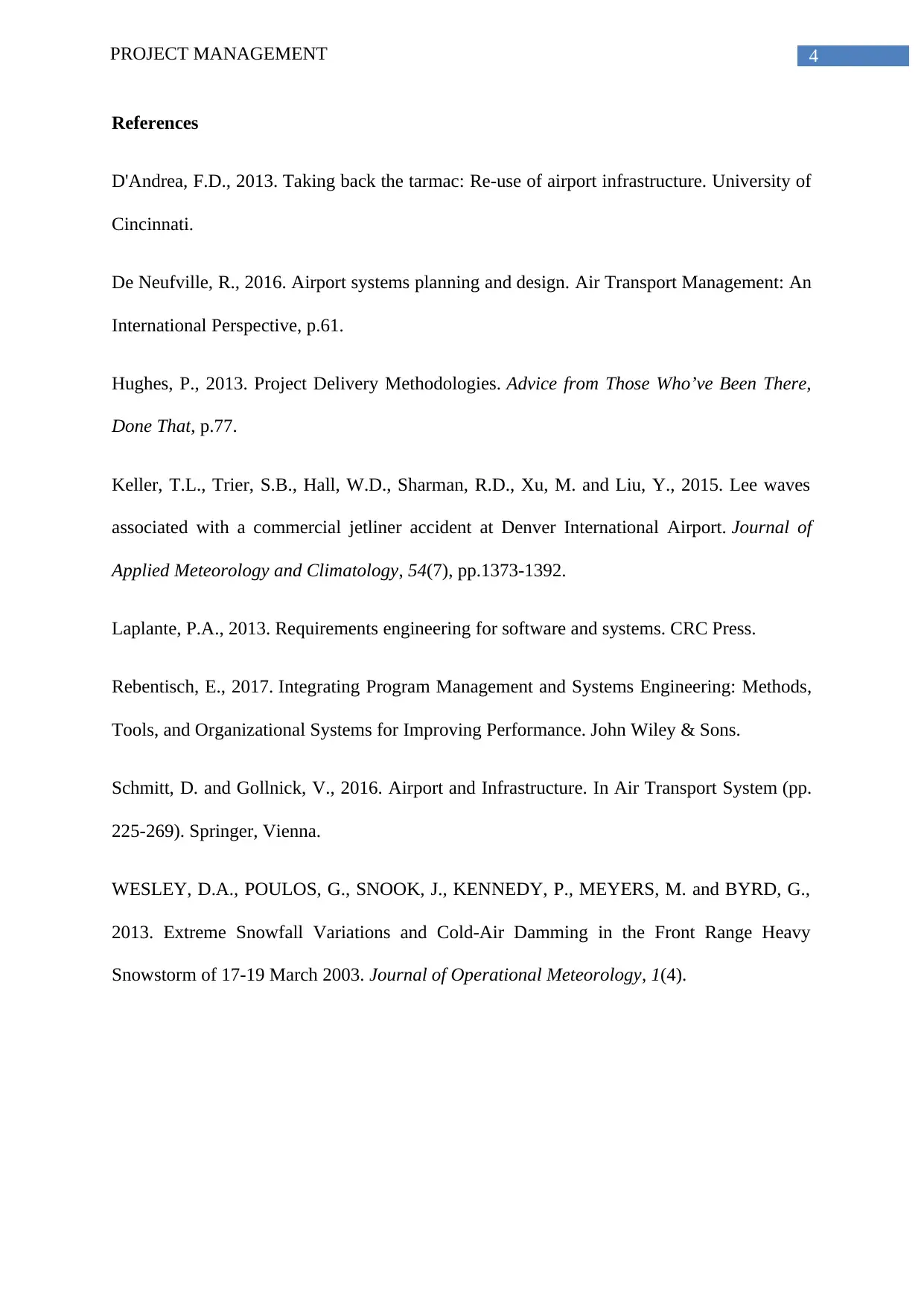Project Management Report: Denver Airport Case Study Analysis
VerifiedAdded on 2021/04/17
|5
|1139
|68
Report
AI Summary
This report delves into the project management aspects of the Denver International Airport (DIA). It examines the strategic soundness of building a new airport, highlighting the reasons behind the decision, such as the limitations of the previous Stapleton airport and the need to address congestion issues. The report also analyzes United Airlines' decision to act as the project manager for the baggage handling system on Concourse B, emphasizing the importance of efficient baggage management for airport operations. The role of the automated baggage system is discussed, as are the design considerations and the benefits of the DCV (Destination Coded Vehicle) system. Overall, the report provides a comprehensive overview of the key project management decisions and their impact on the DIA's functionality and success. It emphasizes the role of technology and strategic planning in overcoming challenges and achieving operational efficiency.

Running head: PROJECT MANAGEMENT
Project Management
Name of the Student:
Name of the University:
Author note:
Project Management
Name of the Student:
Name of the University:
Author note:
Paraphrase This Document
Need a fresh take? Get an instant paraphrase of this document with our AI Paraphraser

1PROJECT MANAGEMENT
Question No 1: Is the decision to build a new airport at Denver strategically a sound
decision? Give reasons and justify your answer
Yes, the decision to build the airport at Denver strategically a sound decision. The
reason behind such is that Denver’s former airport was undergoing a rapid development
before the deregulations (Keller et al. 2015). The deregulation refers to the competition
among open market that could bring the access to air traveling within the reach of common
people, hence maximizing the air traffic at that airport. With the same, the local council of
government anticipated that the Stapleton airport will unable to manage the required traffic
by 2000. The airport could have been updated by giving it a sublet of life for the next coming
5 years, yet the remote place of Denver meant that the potential issue would still linger and
has the potential to cause the Denver city to lose its important business.
Furthermore, the Stapleton airport was one among the important connecting airports
(D’Andrea 2013). It was also ranked among the top eleven worst air traffic congestions in the
United States. Such congestions at the Denver airport influenced the other airports as well, as
it used to have only two runways which were situated very close to each other that in bad
weather were regarded to be one (De Neufville 2016). The newly build airport was
designated to resolve these congestion problems for the city.
The earlier Stapleton airport was highly influenced by the winds of inflated velocity and this
has created in the operations being transfered to the other directions (Wesley et al. 2013).
This procedure has wasted about forty five minutes. The new airport on the other hand would
bring this wasted time to four minutes and this in turn will save both the time and cost for the
very airport. The new airport covers a total land area of about 140 km2. It is to be the largest
airports in the United States in current days and has the potential to handle about 50m of
passengers every year.
Question No 1: Is the decision to build a new airport at Denver strategically a sound
decision? Give reasons and justify your answer
Yes, the decision to build the airport at Denver strategically a sound decision. The
reason behind such is that Denver’s former airport was undergoing a rapid development
before the deregulations (Keller et al. 2015). The deregulation refers to the competition
among open market that could bring the access to air traveling within the reach of common
people, hence maximizing the air traffic at that airport. With the same, the local council of
government anticipated that the Stapleton airport will unable to manage the required traffic
by 2000. The airport could have been updated by giving it a sublet of life for the next coming
5 years, yet the remote place of Denver meant that the potential issue would still linger and
has the potential to cause the Denver city to lose its important business.
Furthermore, the Stapleton airport was one among the important connecting airports
(D’Andrea 2013). It was also ranked among the top eleven worst air traffic congestions in the
United States. Such congestions at the Denver airport influenced the other airports as well, as
it used to have only two runways which were situated very close to each other that in bad
weather were regarded to be one (De Neufville 2016). The newly build airport was
designated to resolve these congestion problems for the city.
The earlier Stapleton airport was highly influenced by the winds of inflated velocity and this
has created in the operations being transfered to the other directions (Wesley et al. 2013).
This procedure has wasted about forty five minutes. The new airport on the other hand would
bring this wasted time to four minutes and this in turn will save both the time and cost for the
very airport. The new airport covers a total land area of about 140 km2. It is to be the largest
airports in the United States in current days and has the potential to handle about 50m of
passengers every year.

2PROJECT MANAGEMENT
Question 6: Why did United Airlines decide to act as the project manager for the baggage
handling system on Concourse B? Give reasons and justify your answer
The united Airlines decided to act as the project manager for the baggage handling
system for many reasons. Airports are mainly judged by the travelers or passangers
depending on their capability to manage and handle the baggage systems. The mechanized
baggage handling system is at the heart of the Denver airports (Schmitt and Gollnick 2016).
Hence, the automated baggage handling system of the DIA or the Denver International
Airport was a great initiative. It is unique within its complexity and anticipated capacity. At
the same time it is a novel technology (Rebentisch 2017). It connects the gates in the three
entrances or concourses where the baggages are loaded on and off the airplane along with
two major terminals where the travelers claim and check their baggage. It is designed in a
way to deliver every bag, including the transfers, independently from the unloading or the
check-ins of the aircraft to the outward baggage reclaim. Despite the main importance of
automated baggage system, the design of the system was greatly an afterthought.
Like the one United Airlines operated in the city of San Francisco, the airline, during
its initial planning stages, stood firm on the automated baggage system. The airline did not
wanted to work on the traditional system of baggage as it was very labor intensive as well as
time consuming. The officials of Denver thereby decided to design the automated baggage
handling system at the Denver International Airport, as speed in handling of baggage is
important in order to achieve the acceptable transfer and boarding times at the Denver
(Hughes 2013).
The changes in the United Airlines were the more important one. It has broaden the
concourse B by eight feet in order to lodge the two moving walkways in every direction. It
Question 6: Why did United Airlines decide to act as the project manager for the baggage
handling system on Concourse B? Give reasons and justify your answer
The united Airlines decided to act as the project manager for the baggage handling
system for many reasons. Airports are mainly judged by the travelers or passangers
depending on their capability to manage and handle the baggage systems. The mechanized
baggage handling system is at the heart of the Denver airports (Schmitt and Gollnick 2016).
Hence, the automated baggage handling system of the DIA or the Denver International
Airport was a great initiative. It is unique within its complexity and anticipated capacity. At
the same time it is a novel technology (Rebentisch 2017). It connects the gates in the three
entrances or concourses where the baggages are loaded on and off the airplane along with
two major terminals where the travelers claim and check their baggage. It is designed in a
way to deliver every bag, including the transfers, independently from the unloading or the
check-ins of the aircraft to the outward baggage reclaim. Despite the main importance of
automated baggage system, the design of the system was greatly an afterthought.
Like the one United Airlines operated in the city of San Francisco, the airline, during
its initial planning stages, stood firm on the automated baggage system. The airline did not
wanted to work on the traditional system of baggage as it was very labor intensive as well as
time consuming. The officials of Denver thereby decided to design the automated baggage
handling system at the Denver International Airport, as speed in handling of baggage is
important in order to achieve the acceptable transfer and boarding times at the Denver
(Hughes 2013).
The changes in the United Airlines were the more important one. It has broaden the
concourse B by eight feet in order to lodge the two moving walkways in every direction. It
⊘ This is a preview!⊘
Do you want full access?
Subscribe today to unlock all pages.

Trusted by 1+ million students worldwide

3PROJECT MANAGEMENT
has added a 2nd level of the baggage service. It also had a roof designed in order to supply
clearstory of the natural light. Moreover, most importantly, the United Airlines wanted a
DCV (Destination Coded Vehicle) baggage handling system as in this system; the luggage
could be shifted in between the gates within less than just ten minutes of time period, thereby
supporting the short turnaround times (Laplante 2013). This handling system (DCV) was to
be on the Concourse B only.
The Denver International airport, after few cogitation came to the conclusion that all
of the concourses at the airport will work on this high speed automated baggage handling
system, rather than bounding it only to the United Airlines,
has added a 2nd level of the baggage service. It also had a roof designed in order to supply
clearstory of the natural light. Moreover, most importantly, the United Airlines wanted a
DCV (Destination Coded Vehicle) baggage handling system as in this system; the luggage
could be shifted in between the gates within less than just ten minutes of time period, thereby
supporting the short turnaround times (Laplante 2013). This handling system (DCV) was to
be on the Concourse B only.
The Denver International airport, after few cogitation came to the conclusion that all
of the concourses at the airport will work on this high speed automated baggage handling
system, rather than bounding it only to the United Airlines,
Paraphrase This Document
Need a fresh take? Get an instant paraphrase of this document with our AI Paraphraser

4PROJECT MANAGEMENT
References
D'Andrea, F.D., 2013. Taking back the tarmac: Re-use of airport infrastructure. University of
Cincinnati.
De Neufville, R., 2016. Airport systems planning and design. Air Transport Management: An
International Perspective, p.61.
Hughes, P., 2013. Project Delivery Methodologies. Advice from Those Who’ve Been There,
Done That, p.77.
Keller, T.L., Trier, S.B., Hall, W.D., Sharman, R.D., Xu, M. and Liu, Y., 2015. Lee waves
associated with a commercial jetliner accident at Denver International Airport. Journal of
Applied Meteorology and Climatology, 54(7), pp.1373-1392.
Laplante, P.A., 2013. Requirements engineering for software and systems. CRC Press.
Rebentisch, E., 2017. Integrating Program Management and Systems Engineering: Methods,
Tools, and Organizational Systems for Improving Performance. John Wiley & Sons.
Schmitt, D. and Gollnick, V., 2016. Airport and Infrastructure. In Air Transport System (pp.
225-269). Springer, Vienna.
WESLEY, D.A., POULOS, G., SNOOK, J., KENNEDY, P., MEYERS, M. and BYRD, G.,
2013. Extreme Snowfall Variations and Cold-Air Damming in the Front Range Heavy
Snowstorm of 17-19 March 2003. Journal of Operational Meteorology, 1(4).
References
D'Andrea, F.D., 2013. Taking back the tarmac: Re-use of airport infrastructure. University of
Cincinnati.
De Neufville, R., 2016. Airport systems planning and design. Air Transport Management: An
International Perspective, p.61.
Hughes, P., 2013. Project Delivery Methodologies. Advice from Those Who’ve Been There,
Done That, p.77.
Keller, T.L., Trier, S.B., Hall, W.D., Sharman, R.D., Xu, M. and Liu, Y., 2015. Lee waves
associated with a commercial jetliner accident at Denver International Airport. Journal of
Applied Meteorology and Climatology, 54(7), pp.1373-1392.
Laplante, P.A., 2013. Requirements engineering for software and systems. CRC Press.
Rebentisch, E., 2017. Integrating Program Management and Systems Engineering: Methods,
Tools, and Organizational Systems for Improving Performance. John Wiley & Sons.
Schmitt, D. and Gollnick, V., 2016. Airport and Infrastructure. In Air Transport System (pp.
225-269). Springer, Vienna.
WESLEY, D.A., POULOS, G., SNOOK, J., KENNEDY, P., MEYERS, M. and BYRD, G.,
2013. Extreme Snowfall Variations and Cold-Air Damming in the Front Range Heavy
Snowstorm of 17-19 March 2003. Journal of Operational Meteorology, 1(4).
1 out of 5
Your All-in-One AI-Powered Toolkit for Academic Success.
+13062052269
info@desklib.com
Available 24*7 on WhatsApp / Email
![[object Object]](/_next/static/media/star-bottom.7253800d.svg)
Unlock your academic potential
Copyright © 2020–2025 A2Z Services. All Rights Reserved. Developed and managed by ZUCOL.
